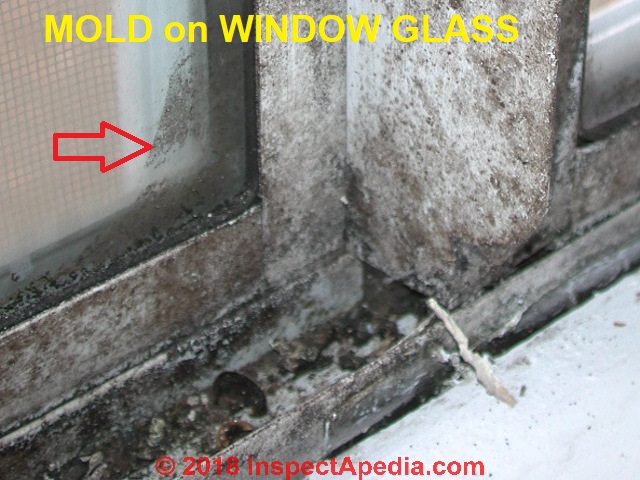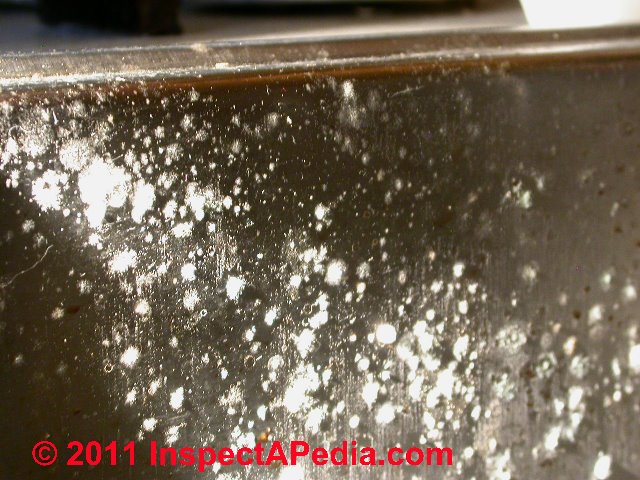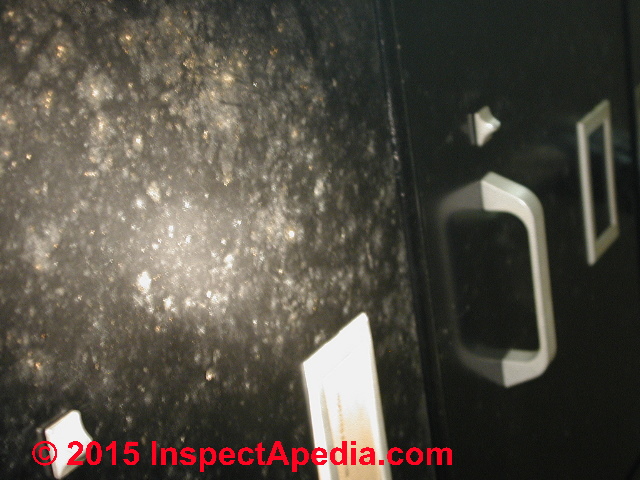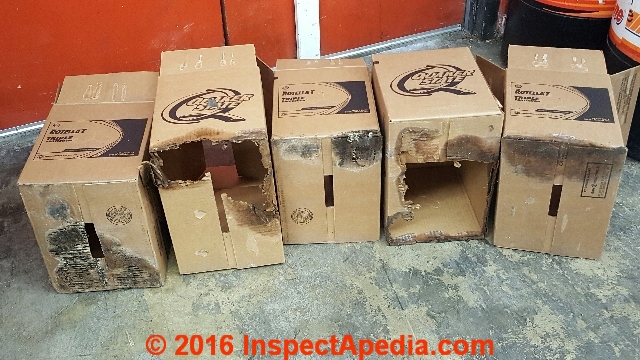 Mold In-Situ: Photos of Mold on Surfaces - Group 6
Mold In-Situ: Photos of Mold on Surfaces - Group 6
Appearance of Mold on Different Materials & Surfaces.
- POST a QUESTION or COMMENT about what mold looks like in buildings, including mobile homes and trailers
Photographs of mold growth in buildings:
Here is an extensive photo guide to mold growth on things found around the home or in it including mold on plastic or rubber garden hose, mold on glass surfaces such as window panes, mold on hardboard used indoors, mold on houseplants, mold on insulating boards and sheathing, mold on or in fiberglass insulation, mold on or in foam insulating boards or spray foam, moldy mattresses and bedding, even pillow-cases, mold in metal stud walls, mold on metal surfaces such as filing cabinets, mold in modular homes or other modular buildings.
What does mold look like growing on various building & other material surfaces? Here is an online reference photo library of various kinds of mold as it is found growing on a wide range of surfaces and materials found on or in buildings. These photos of mold on indoor various materials or "mold growth substrates" may help you recognize mold in buildings, recognize probably-cosmetic mold, and recognize stuff that is not mold and does not need to be tested.
InspectAPedia tolerates no conflicts of interest. We have no relationship with advertisers, products, or services discussed at this website.
- Daniel Friedman, Publisher/Editor/Author - See WHO ARE WE?
Pictures of Mold on Various Building Surfaces and Materials
For page loading speed we have divided this article into several sections. Use the link
MOLD APPEARANCE on VARIOUS SURFACES - INDEX
to return to the index / list of photographs of the appearance of mold on various building materials & contents.
--- MOLD GROWTH on MATERIAL SURFACES PHOTOS GROUP 6 ---
- MOLD on GARDEN HOSE
- MOLD on GAS FIREPLACE CERAMIC
- MOLD on GLASS SURFACES
- MOLD on HARDBOARD, Masonite™
- MOLD (MILDEW) on HOUSEPLANTS
- MOLD on INSULATING BOARDS, Homasote™ Celotex™
- MOLD on /in INSULATION, FIBERGLASS, FOAM
- MOLD on LUGGAGE (mold on NYLON or other synthetic fabric)
- MOLD on MATTRESSES, BEDDING
- MOLD on METAL STUD WALLS
- MOLD on METAL SURFACES, Filing Cabinets, Stainless Steel Sink, Steel Columns
- MOLD in MOBILE HOMES DOUBLEWIDES & TRAILERS
- MOLD in MODULAR HOMES
- MOLD in MOTOR OIL & LUBRICANTS
Photographs of mould found on the surface of items, materials, & surfaces found indoors
[Click to enlarge any image]
Mold on Garden Hose

This photograph illustrates mold growth on a common garden hose.
Also see MOLD on RUBBER for other examples of mold growth on rubber or see MOLD on VINYL WINDOWS for examples of mold growth on vinyl.
Mold on Gas Fireplace Ceramic Backer
 Reader question: is this mold on this old gas fireplace insert?
Reader question: is this mold on this old gas fireplace insert?
This fireplace panel where the flames go is green and black, it is not fuzzy and cannot scrape with fingernail.
It does not fade with bleach or mold remover…just curious, do you know if this is a color from flames burning over time.
The apartment does not have any mildew or dampness under rug (replaced it) and the walls are not moldy behind wallpaper (removed and painted) and it is dry.
Do you know if this is a discoloration that old fireplace inserts get? I could not find this addressed on your website.
I called an antiques dealer in Wash. DC as he had photos of similar fireplace inserts in his store for sale and says its wear. - Anonymous by private email 2016/07/29
Reply:
It's an odd pattern that doesn't look flame-related; but if the stains were from algae or mold on a ceramic surface I'd think they'd at least lighten with use of a cleaner or bleach solution.
The photograph itself is insufficient, and your description of inability to remove any of the green and black stain areas by cleanign or wiping argues against it, but the pattern and colors do look a bit like mold growth.
Please see GAS FIREPLACE CERAMIC STAINS where we discuss this gas fireplace and its stains in detail.
Although the pattern, texture, and color of the deposits in this gas fireplace look like mold in the photo, without a laboratory test of a surface sample of these deposit mateirals we cannot know for sure what they are and thus we won't be sure about how to remove them nor whether or not the deposits indicate other unsafe conditions.
At MOLD TEST KITSI describe the method I recommended to you for collecting tape samples suitable for settled dust, mold or other particle examination tests.
You can use this procedure for surface dust or debris analysis byt any qualified mold or forensic laboratory.
Watch out: If gas fireplace deposits are sooty and are being caused by a burner or combustion air defect the system is unsafe and should be left shut down until it can be inspected and reparied; combustion defects on gas fueled appliances risk fatal carbon monoxide poisoning.
See CARBON MONOXIDE WARNINGS: HOME HEATERS
Mold on Glass Surfaces
Above: an obviously moldy window frame is also sporting mold growth on the window glass itself. The very smooth edge of the mold growth (red arrow) is probably the result of someone having wiped most of the glass surface during cleaning.
Mold found "growing" on glass is most likely growing on organic deposits that are on the glass surface like the overflows on the wine brewing bottles showing below.
We have also observed more serious damage to glass lenses on cameras and binoculars exposed to mold. In that case mold is attacking coatings on the lenses.

Mold on Hardboard, Masonite™
Below you can just see white fungal mycelia that permeated this sample of hardboard siding that had been used as wall paneling in a church's damp basement.

Mold on Houseplants - It's Mildew

Above we show white mildew on the leaves of a Jasmine plant that moves between indoors and outside at our house. Left outside in the sun and not over-watered the plant generally doesn't have a mildew problem.
. But indoors, over-watered, or outdoors in shade and in rainy weather, the leaves can quickly become covered with white mildew.
Mildew only grows on living plants so if you see white mold on your shoes or somewhere else, unless they're made out of green leaves, it's not mildew.
For details on what to do about cleaning off or removing mildew, and how to both cure and prevent mildew.ee
Mold on Insulating Boards, Homasote™ Celotex™

This photograph illustrates mold growth on insulating board product whose principal ingredient is wood fibers.
Mold on Insulation, fiberglass, foam
Mold on Insulation Kraft Paper Facing
In our photo above we see black mold and other mold growths on the kraft paper facing of fiberglass building insulation.
Our black mold photo on kraft paper found on a different section of building insulation (below) illustrates mold colonies that do not always grow in round colonies shown other mold photographs.

Below our photograph shows mold on the wrap covering fiberglass insulation used on piping.
Watch out: black stuff is not always mold: at below right our photograph of a black streak across a batt of fiberglass insulation is an example of a marking that a client thought was mold contamination. The black material was a pigment, not mold, and was associated with the product's manufacturing process.
Watch out again: However other samples of this fiberglass batt were found to be contaminated with Aspergillus sp. - it was not visible to the naked eye.
More building roof insulation mold in a different growth pattern is below.
Details about fiberglass insulation mold contamination, testing, and research begin at FIBERGLASS INSULATION MOLD
Mold on Foam Insulation
Below: this photograph of mold on foam building insulation, courtesy of Tampa home inspector Mark Cramer, is discussed in the mold-on-foam article we cite just below.
Details about mold growth in or on foam insulation are at MOLD in FOAM INSULATION
The following photograph illustrates mold growth on asbsestos pipe insulation.
More photos of moldy pipe insulation are at MOLD on ASBESTOS PIPE INSULATION
Mold on Luggage, Mold on Nylon, other Synthetic Fabrics
Above: mold on luggage, probably ripstop nylon.
Also see MOLD on CLOTHING, CLOTH, BEDDING - varies by material type, cotton, wool, etc.
Mold on Mattresses, Bedding
The mattress and bedding photographs shown above along with more images are discussed at MOLD ON CLOTHING, CLOTH, BEDDING
Mold on Metal Stud Walls
Here are photographs from two different buildings each of which suffered significant mold contamination in the metal wall stud cavity. Both buildings conducted water around the walls from a single leak point source when water flowed in the metal sill plate.
The severe mold contamination in the wall cavities shown above was detected by first making a very small test cut in a suspicious area (where flooring was buckled).
See HIDDEN MOLD in CEILINGS / WALLS for details.
Mold on Metal Surfaces, Stainless Steel sink, Mold on Steel Lally Column
It's less surprising to find mold growth on a stainless steel surface if you consider that the surface may have had a film coating of food or other organic material.
The moldy stainless steel sink in these photographs was in a home that had been left flooded for two or more weeks.
Below we illustrate white mold growth on the painted surface of a concrete-filled steel Lally column in the basement of a home examined by an InspectApedia reader (below left), and mold growth on the painted surface of a metal filing cabinet that was inspected in the flooded basement of a White Plains NY office building (below right).
Below: mold on a steel filing cabinet.
Reader Question (about the white mold-like material on the steel Lally column shown at above left):
I was hoping you could help me identify a growth that I just saw yesterday on a house I was touring. It was located on the steel beams in the basement only, so I thought that was odd, as some things I have read indicated that mold does not really like to grow on metal (not a food source).
There is no other evidence of water damage in the basement. Any ideas as to what the growth in the attached pictures could be? - M. 15 Feb 2015
Reply: most likely this is a white fungus growing on the painted surface of a steel Lally column
There are two candidates for this white material:
Likely: a white fungus (mold). You're right that most molds don't like to grow directly on steel but this is painted steel and plenty of fungi like various paints. In fact I've collected mold samples even from stainless steel and glass surfaces, though IMO in those cases it was actually living on a coating on that surface such as a lens coating or a food, dust or debris coating that contained organics.
See WHITE MOLD PHOTOS
Some white or light coloured molds such as (but not limited-to) members of the Penicillium or Aspergillus genera can produce small, easily-airborne toxic or pathogenic mold spores that present a health risk to building occupants.
Unlikely: a mineral salt (effloresence) that is unlikely unless the Lally column has been wet AND has numerous pinholes right through the steel (effloresence is a mineral salt left on surfaces when salts leached by moisture from a masonry material such as concrete are left on the surface)
See EFFLORESCENCE SALTS & WHITE DEPOSITS
When I magnify your image I see what looks like a fungal growth material but my view is limited. A close-up examination by high power magnifying glass would perhaps reveal either an organic or fungal structure or crystalline structure characteristic of effloresence. Without a tape sample with which in our lab we could make a definitive particle identification, I'm guessing that the white material on the steel column in your photo is a white fungus.
What does this mean to you? Maybe not much, but I'd be alert for high moisture in the basement where these posts were found since in either case this white stuff is a moisture indicator. Why "just" on these posts?
- Condensation formation rate on the post surfaces may have been more than on other nearby surfaces
- Mold friendliness of the particular paint used or possibly even other organic dust that was on the column surface. For example I've taken mold growth samples from un-painted concrete block walls in a basement where organic-containing dust from dogs (who were sequestered there) had been deposited on those surfaces.
- Possibly there were other moisture signs that have been removed, cleaned-up, painted over.
Reader follow-up: is this white fungus dangerous?
... if it is indeed a white fungus- is it hazardous? The house is bank owned and otherwise in great shape, but the fact that it's bank owned means I'll be responsible for any kind of remediation and also stuck with the outcome.
Reply:
... you know what I'm going to answer so I'll be brief:
Only a fatuous fibber or fool would pretend to tell you that s/he can identify the genera and species of white stuff that looks like mold on a Lally column based on a photo, much less to assert just how safe or dangerous it is.
There are about 1.5 million mold species, about 80,000 that have been well studied, and probably thousands of species that are white, and perhaps hundreds that we know about and that are white and that might grow on a painted steel surface.
The total area of mold represented by white mold-suspect material on a Lally column is likely to be trivial - not sufficient by itself to merit professional treatment (it's less than 30 sq.ft. of contiguous mold). Remove it, clean the surfaces, using any household cleaner and taking common sense personal protection (eyes, skin &c)
General safety advice:
1. Don't put a dirty mold-covered finger in your eye - you could get an eye infection
2. Heed my warning that the conditions that produced the mold you can see may have produced more important mold growth that you haven't seen. Look for the possible causes of water entry, leaks, high humidity, condensation - and fix those.
OPINON: a house that is bank-owned is more likely than others to have been left unattended - which can explain leaks, moisture, condensation - and to have been cleaned and prepped for re-sale by a contractor who is charged with making things look good at the lowest cost. If you find an inspector who has no conflicts of interest, and who has your interest in mind, s/he ought to be able to reduce for you the risk of surprises - reduce, not eliminate them.
Mold on & In Mobile Homes, Doublewides, Trailers
Above: extensive whit
See details at MOBILE HOME MOLD CONTAMINATION
Mold in Modular Homes
Mold may be found in surprising locations in modular homes depending on the home's delivery conditions and construction history.
Residential modular home structures include cavities between floors and some walls that an inexperienced inspector may fail to consider. Knowing that water had entered this modular structure we obtained permission for some destructive inspecting that helped track how water had moved through the building.
For details about the causes of and detection of mold contamination in modular constructed homes
see MODULAR HOME MOLD CONTAMINATION
Also see MOLD GROWTH on SURFACES, TABLE OF our table of mold growth locations in buildings
where we include MOBILE & MODULAR HOME MOLD
Mold in Motor Oil & Lubricants
Above we see mold on wet cardboard boxes used to store Quaker State motor oil, contributed by reader [Anonymous] 2016/08/25 by private email. The reader commented and then asked:
Might be from a leak from neighbors bathroom. No product leaked out of containers in boxes, but was asked if mold and mushrooms can grow in clean motor oil.
Motor oil, itself toxic to most living organisms, will not be found supporting visible mold growth. On the other hand, it is not accurate to say that absolutely no microorganisms "grow" in or function in motor oils. Walker (1975) discussed the effects of thermophilic bacteria and mold on the break down of motor oil of the type likely to be found in nearshore wastewater discharges and wastewater. See
- Al-Maghrabi, Ibrahim MA, AO Bin Aqil, M. R. Islam, and O. Chaalal. "Use of thermophilic bacteria for bioremediation of petroleum contaminants." Energy Sources 21, no. 1-2 (1999): 17-29.
- Lefcort, H., K. A. Hancock, K. M. Maur, and D. C. Rostal. "The effects of used motor oil, silt, and the water mold Saprolegnia parasitica on the growth and survival of mole salamanders (Genus Ambystoma)." Archives of Environmental Contamination and Toxicology 32, no. 4 (1997): 383-388.
- Ijah, U. J. J., and L. I. Ukpe. "Biodegradation of crude oil by Bacillus strains 28A and 61B isolated from oil spilled soil." Waste Management 12, no. 1 (1992): 55-60.
- Ludzack, F. L., and Diana Kinkead. "Persistence of oily wastes in polluted water under aerobic conditions." Industrial & Engineering Chemistry 48, no. 2 (1956): 263-267.
- Stone, R. W., M. R. Fenske, and A. G. C. White. "Bacteria attacking petroleum and oil fractions." Journal of bacteriology 44, no. 2 (1942): 169.
- Walker, J. D., R. R. Colwell, and L. Petrakis. "Bacterial degradation of motor oil." Journal (Water Pollution Control Federation) (1975): 2058-2066.
CONTACT us to submit photographs of mold growth on other man-made or building-related materials.
...
Continue reading at MOLD GROWTH on SURFACES, PHOTOS_GROUP_7 or select a topic from the closely-related articles below, or see the complete ARTICLE INDEX.
Or see these
Mold Identification Articles
- BLACK MOLD, HARMLESS
- MOLD APPEARANCE on VARIOUS SURFACES index to photos of mold on all kinds of surfaces and materials
- MOLD APPEARANCE - WHAT MOLD LOOKS LIKE - home
- MOLD APPEARANCE - STUFF THAT IS NOT MOLD
- MOLD ATLAS & PARTICLES INDEX
- MOLD FREQUENCY in BUILDINGS
- MOLD in BUILDINGS
- MOLD CONTAMINATION IN BUILDINGS - home
- MOLD by MICROSCOPE - mold under the microscope
- MOLD in the PETRI DISH, PHOTOS - mold on culture plates or in culture-type mold test kits
- MOLD RELATED ILLNESS SYMPTOMS
Suggested citation for this web page
MOLD GROWTH on SURFACES, PHOTOS_GROUP_6 at InspectApedia.com - online encyclopedia of building & environmental inspection, testing, diagnosis, repair, & problem prevention advice.
Or see this
INDEX to RELATED ARTICLES: ARTICLE INDEX to MOLD CONTAMINATION & REMEDIATION
Or use the SEARCH BOX found below to Ask a Question or Search InspectApedia
Ask a Question or Search InspectApedia
Try the search box just below, or if you prefer, post a question or comment in the Comments box below and we will respond promptly.
Search the InspectApedia website
Note: appearance of your Comment below may be delayed: if your comment contains an image, photograph, web link, or text that looks to the software as if it might be a web link, your posting will appear after it has been approved by a moderator. Apologies for the delay.
Only one image can be added per comment but you can post as many comments, and therefore images, as you like.
You will not receive a notification when a response to your question has been posted.
Please bookmark this page to make it easy for you to check back for our response.
IF above you see "Comment Form is loading comments..." then COMMENT BOX - countable.ca / bawkbox.com IS NOT WORKING.
In any case you are welcome to send an email directly to us at InspectApedia.com at editor@inspectApedia.com
We'll reply to you directly. Please help us help you by noting, in your email, the URL of the InspectApedia page where you wanted to comment.
Citations & References
In addition to any citations in the article above, a full list is available on request.
- [2] Dictionary of the Fungi, 9th Ed., PM Kirk, PF Cannon, JC David, && JA Stalpers Ed., CABI Publishing 2001 ISBN 0 85199 377 X www.cabi.org UK
- In addition to citations & references found in this article, see the research citations given at the end of the related articles found at our suggested
CONTINUE READING or RECOMMENDED ARTICLES.
- Carson, Dunlop & Associates Ltd., 120 Carlton Street Suite 407, Toronto ON M5A 4K2. Tel: (416) 964-9415 1-800-268-7070 Email: info@carsondunlop.com. Alan Carson is a past president of ASHI, the American Society of Home Inspectors.
Thanks to Alan Carson and Bob Dunlop, for permission for InspectAPedia to use text excerpts from The HOME REFERENCE BOOK - the Encyclopedia of Homes and to use illustrations from The ILLUSTRATED HOME .
Carson Dunlop Associates provides extensive home inspection education and report writing material. In gratitude we provide links to tsome Carson Dunlop Associates products and services.






















